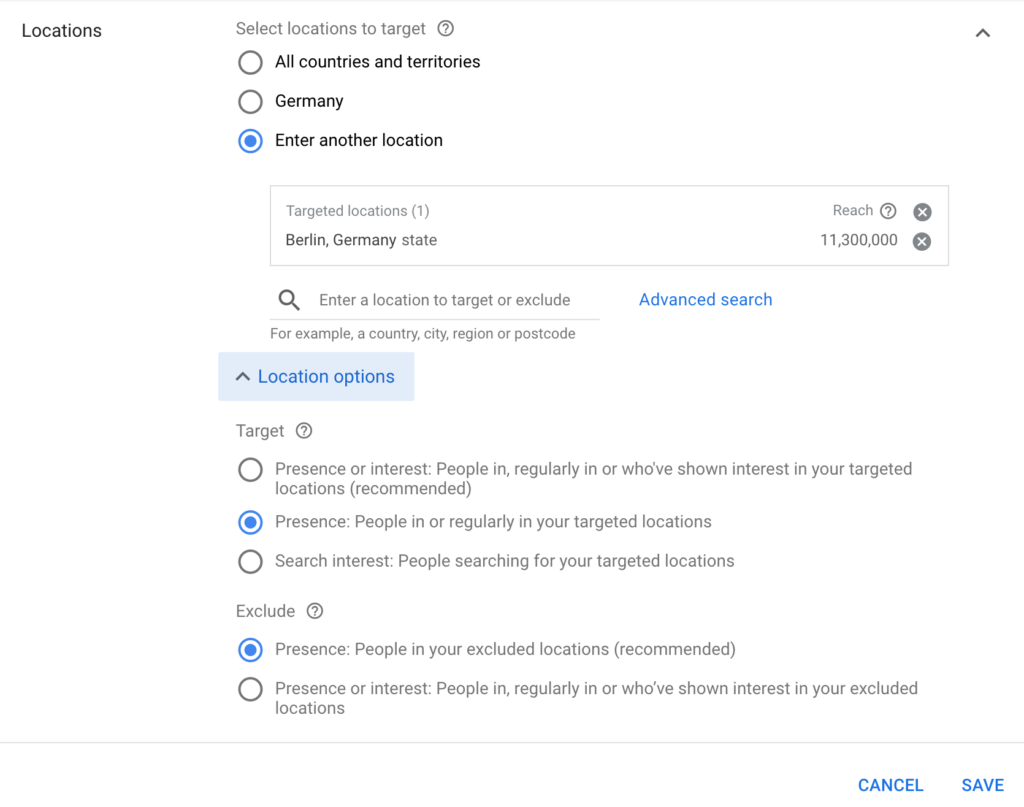

Geographic targeting allows you to target ads to specific locations and explicitly exclude others. This allows you to target your audience more precisely and increase your return on investment. We’ll show you how to reduce and control wastage with geographic targeting!
Nowadays, we are always and everywhere online with our smartphones. This also means that more and more people are searching for offers and services while on the move. As users, we expect the search to show offers that are actually available. If a user is looking for dog food in Germany, he will hardly find an ad from a provider that does not deliver to Germany helpful.
With geographic targeting, you can define in Google Ads the locations where your ads are to be broadcast and the locations where they are not. Locations can be countries, regions, cities or even certain radiuses of a selected location. Google Ads takes into account the location of the user or the users who are interested in this location, depending on the alignment method. Where exactly the difference lies, we will explain in the next sections. In general, you can add up to 1000 different locations to your Google Ads account, via bulk or select method.
Wondering about the benefits behind it? Geographical targeting allows you to define your target group more precisely and thus avoid wastage. If you don’t deliver to certain regions, for example, it’s hardly worthwhile to place ads in these regions. If, on the other hand, you select specific locations in which your ads are to be broadcast, you will reach precisely those users who belong to your potential customers. This means that you can target your ads more effectively, which can lead to an increase in conversion rates and ultimately increase your return on investment (ROI). We therefore strongly recommend that you add suitable locations to your campaigns.
Google offers various location settings, which we will explain to you below. It is important that you ask yourself at the beginning whether your potential customer is frequently or currently at a certain location or whether a pure interest in the location is sufficient. Interest would exist, for example, if someone is looking for a hotel in Paris but lives in Berlin. So he is neither frequently nor now in Paris, but is interested in a service there.
The following setting options regarding the locations are available for you to choose from:

The same is true for location exclusions. If you exclude locations, you prevent ads from being presented to users in certain target regions. This allows you to use your budget more effectively and target only users who can access your product or service. An exclusion can be useful, for example, if you do not supply a region or your service is not offered there (e.g. no shipping to Switzerland). Another example is special offers, which are available in some locations but not in others.
For the exclusions you have the choice between the following two options:
So much for your options, but when is which setting the right one? This depends a lot on your objective, your offer and your budget. It’s important to assess where your target audience spends most of their time and how realistic it is that your ideal customer will convert from that location.
If a Hamburg dog salon, for example, uses the default setting “Presence and interest”, the ad will not be played out exclusively in Hamburg, but also in all other cities when “Hamburg dog salon” is searched for. But does it make sense for the dog salon in Hamburg if the ad is played out in Munich? Depending on the case, it is quite possible that the searcher will travel from Munich to Berlin in the near future and would like to have his dog groomed there.
However, you should not forget the following: Broadcasts can lead to paid clicks. So it is important to put the probability of the salon visit in relation to the budget. But even without click costs, it is questionable whether a broadcast in Munich and other locations makes sense. If users do not click on the ad (because they do not want to travel to Berlin), the click-through rate drops, which in turn can affect the quality factor. If this deteriorates, the placement of ads becomes more expensive, which also leads to additional costs.
As you can see, there is no one-size-fits-all answer. Instead, you have to weigh things up individually. We would also like to give you another important point at this point: Pay attention to the language of your ads! If you want your ads to be played in France, you should make sure that the ad text is in French and that you do not place any German ad texts.
Conclusion: Geographic targeting is an important targeting option for your Google Ads campaigns. Which setting is the right choice depends on your target group. To begin with, think about where your potential customers are and estimate how you can use your budget most effectively. Do you have questions about geographic targeting? Then don’t hesitate to contact us, we’ll be happy to help you!